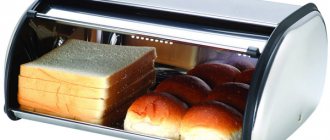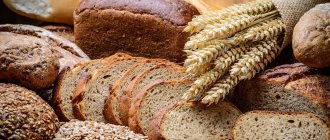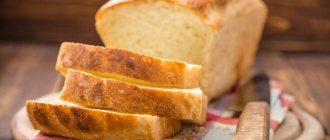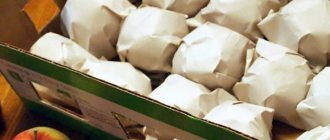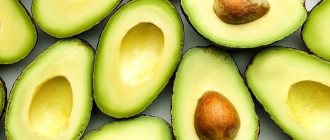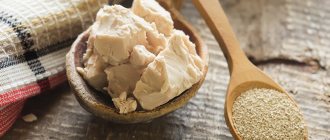Why does bread get moldy?
Mold is a disease of bread. It starts like this: moldy fungi infect the surface of a baked goods product. This happens when the bread is already cooked: fungal spores do not like high temperatures and die if it is above 65-80°C.
Mold spores live in the air. Therefore, there are many options for getting infected. When the bread was just taken out of the oven. When it is laid down or transported.
Some types of bread are more susceptible to molding, others less so. Here are the main factors that influence:
- type of bread (composition, acidity, recipe);
- method of preparation (sponge, straight, accelerated methods, sourdough);
- processing of bread after baking (is there heat treatment, microwave irradiation, etc.);
- storage conditions (temperature, humidity, storage period, microbiological state of the environment).
Photo pexels.com.
Experts say that “healthy” bread made from wheat flour under normal storage conditions can become moldy as early as 4-6 days. If the bread is rye or from a mixture of rye and wheat flour, then a little later. About a week after production. But black bread may not go moldy for a longer period of time. And this is not at all due to preservatives, but due to the high acidity of the product, which is provided by rye flour and the sourdough method of preparation.
Bread that is prepared using accelerated technology will also not mold for a long time . That is, to which improvers are added. Such bread contains acidulants, which are responsible for combating microbiological spoilage of bread, including the formation of mold.
What is the harm of black bread: talking about potassium ferrocyanide What exactly extends the life of bread? In production, this can be iodized salt: it inhibits molding for up to 14 days or even more. The folk “fighters” against mold are kefir and whey.
But if the bread contains bran, wheat germ, vegetable and fruit particles or powders, cereals (rice, barley, oats, buckwheat), the bread will mold faster.
Photo pexels.com.
Harm caused
Any type of mold other than the one discussed above poses a risk to human health that will be caused even by normal inhalation. Microbial spores, being in the air, instantly penetrate inside.
Many people, having discovered a moldy area, cut it off, leaving the remaining, uninfected part for use. Doing this is strictly prohibited, since invisible microorganisms cover the entire cavity of the loaf and can cause serious intoxication.
The danger comes not only from eating mold, but from inhaling it . The risk of respiratory tract diseases, which can become chronic, is growing. Certain types of pathogenic microbes affect the nervous and circulatory systems, change hormonal levels, and reduce the protective function. The extent of damage depends on the type of fungus and the duration of inhalation. The following symptoms of poisoning may occur:
- Inflammation of the nasal mucosa.
- Skin rashes.
- Nausea, vomiting, diarrhea.
- Dizziness.
- Drowsiness.
- Poor general health, weakness, fatigue.
Intoxication occurs from four hours to several days after contact. The most severe symptoms occur in children. Further, the risks of developing bronchial asthma, bronchitis, and fungal pneumonia increase.
The victim may experience an allergic reaction - Quincke's edema, or anaphylactic shock, which poses a great threat to life. Therefore, after the first signs of symptoms appear, you must immediately call an ambulance.
Before the doctors arrive, it is necessary to carry out a number of actions to cleanse the body of toxic substances:
- Stomach cleansing . The patient should drink a liter of clean water at a time. This is necessary to provoke vomiting, as a result of which the remaining toxins will be eliminated. Next, you need to take a sorbent, for example, activated carbon.
- Drink plenty of fluids . After stopping vomiting, you need to drink as much water or sweet tea as possible.
- Taking allergy medications.
What to do to prevent bread from becoming moldy
We list the basic rules that prevent bread from molding:
- Do not store white and brown bread together. If it's a bread box, put it in different sections. If stored in the refrigerator, then in different bags. Preferably in paper.
- It is recommended to periodically treat the bread box, boards and knives with a 3% vinegar solution. After treatment, rinse with soapy water and dry thoroughly.
- You can put a handful of salt or a piece of potato in the bread box. They will absorb excess moisture and your bread will last longer.
- If possible, store bread in the refrigerator.
- If you are leaving somewhere, you can cut the bread and freeze it. Upon return, bring it to the usual state at room temperature and eat calmly.
If you need to take bread on the road , put it in a plastic bag along with an iodine bottle. Soak a cotton swab with 10 drops of iodine. Place the swab in a small container and cover with a clean piece of cotton wool. Place the bottle in a bag: iodine vapor will create unfavorable conditions for mold. The taste of the bread will remain the same.
It is important to understand: if the bread begins to mold, then the structure of the product is damaged and should not be consumed . It is a misconception that if you cut off the affected pieces or heat them on fire, everything is fine. No. Microorganisms have already managed to penetrate inside the bread.
Photo pexels.com.
First aid for mold poisoning
If symptoms of mold poisoning become obvious and you have already called an ambulance, provide first aid.
First of all, cleanse the patient's body of toxins. Rinse your stomach. Pour at least a liter of water into the patient so that he vomits. After this, give a cleansing enema with water at room temperature. If mold gets into the human body, take sorbents. The most famous: Smecta, Atoxil, Enterosgel. Before medical intervention, give the patient plenty to drink. Sweet tea is especially good in this situation. If he is rejected, let him drink ordinary boiled water at room temperature. This is necessary in order to prevent intoxication of the body. Anyone can provide first aid for bread mold poisoning. The main thing is not to panic, but to remember what can be done to help the patient get rid of the symptoms of severe intoxication.
We advise you to read: “What to do if you are poisoned by mold: first aid, possible consequences.”
Why does bread mold in the bread bin?
The bread in the bread bin becomes moldy due to improper storage. Or there is high relative humidity in the bread bin. A piece of potato or salt will help. Or you store black and white bread close to each other. Separate them with a partition (if one is not provided initially).
Remove mold stains from the bread bin with a weak vinegar solution. After treatment, the surface is washed with soapy water (all the same as in the case of cutting boards).
It is important to know that if bread in your home becomes moldy and sits like that for even a day, mold spores will remain in the air and will contaminate other products for a long time. They can switch to other bakery products, cheese. Moreover, spores migrate and can reach neighbors through ventilation. To avoid a dangerous neighborhood, observe the temperature regime at home, ventilate and monitor food. When mold first appears, treat surfaces and destroy affected food.
How to choose the right milk and how to avoid being deceived by dairy products.
Why is mold dangerous?
Molds are considered the strongest allergens. In a person prone to allergies, they cause a serious reaction, even if they enter the body in small quantities.
Mold spreads very quickly. Fungal spores can settle on the lungs. If you eat moldy bread, it can cause the development of acute respiratory reactions from a simple cough to bronchial asthma.
Mold on bread is especially dangerous for children and people who have problems with the digestive tract.
We recommend reading: Why is mold dangerous to your health? (What damage can it cause)
It is important to know that mold on bread can not only be eaten, but also inhaled. Therefore, the consequences of eating moldy bread are different.
If the bread goes moldy quickly
The cause of moldy bread is improper storage. The reason could be this:
- air temperature 25-30 degrees Celsius;
- in the room where the bread is stored, the humidity is above 70 percent. Moreover, the “disease” can also begin in the store where you bought the bread;
- incorrect manufacturing technology: increased moisture content in the product or dense packing during transportation;
- infection with fungal spores through dirty air, vehicles, dirty hands and clothes of people;
- if mold has grown from the inside, then the problem is in the raw materials: for example, flour or other ingredients were contaminated.
How to grow mushrooms in the country: your own oyster mushrooms all summer long.
Plant nutrition
There is a belief that even spoiled bread should not be thrown away. But not everyone will agree to eat even a fried or baked moldy product. Therefore, housewives are racking their brains over where to put the contaminated food .
Flour products usually contain yeast. They are used to fertilize the soil before planting. The substance contains B vitamins and carbon dioxide. If a lot of moldy bread has accumulated, then the infected crusts are cut off and broken into small slices. Then prepare a solution consisting of several ingredients:
- two armfuls of stinging nettles;
- 2 kg of sugar or old jam, berries from compotes;
- 1 stick of yeast;
- 4−5 kg of bakery products.
Nowadays, you can go out and buy bread at any time of the day, and there is no need to stock up on these products for future use. But what to do if the bread is moldy? This often happens after the holidays, when the guests at the table did not eat the sliced loaf, and it began to mold. It is also not uncommon for each member of the household to buy some bread home from work and it turns moldy because you did not have time to eat it. So what to do in such a situation?
Secrets of healthy bread
Yeast promotes the development of mold . Give preference to yeast-free varieties.
Dry fresh bread slightly. You can put it in the oven for a couple of minutes. Dried bread slows down the development of mold. In principle, light freezing gives a similar effect, which is why many people store bread in the refrigerator.
If you store bread in a bag, make sure that the bread “breathes.” It can “suffocate”, which causes mold again.
What kinds of pasta are there and what sauce to choose for them.
Folk remedies
The first results of using bread fertilizer are visible after 5-7 days, so there are many ways to use it both for home flowers and for the garden.
Bread waste
Any unclaimed baked goods will be useful for preparing top dressing. They are placed in a container (it is more convenient to use a can or enamel bowl) and filled with warm water so that the tops of the crackers are covered with liquid by 5 centimeters. For efficiency, you can put something heavy on top, creating pressure.
The container is placed in the sun or other warm place and kept there for about two weeks. Once ready, the mixture is diluted with water (1:1) and used for foliar feeding.
Traditional yeast fertilization
This recipe is designed for large volumes of feeding. A kilogram of live fungi is poured into 11 liters of water, brought to homogeneity and immediately watered without fermenting the mixture. It is better to do this in warm weather or just before it.
The recipe is suitable for all types of garden crops and home flowers.
Mash for plants
This remedy is most often used for tomatoes and potatoes. It is not very different from ordinary mash, but you should not use it internally: if the technology changes, the human body may be poisoned.
Preparation procedure: add ½ cup of sugar and 3 liters of water to 100 g of yeast, mix until smooth and leave in a warm place for a week. Dilute 250 ml per 10 liters of water. One plant requires about a liter of solution.
Fertilizer for strawberries
If rot begins to appear on fruits or greenery, you can revive the plantings with the help of yeast. It is best to take live ones, not fast-acting ones. For every 100 g of fungi there should be 10 liters of water (a smaller volume of liquid is allowed if the process is running). This solution is used to water the bushes and spray the leaves (not in sunny weather, so as not to burn), and is also used for seedlings, increasing their chances of successful transplantation.
To fertilize home and garden crops, you can apply homemade fertilizer. It’s easy to do: no special knowledge or skills are required.
In our modern age, the counters of gardening stores never cease to amaze us with an incredible abundance of various fertilizers. Meanwhile, you can feed garden crops and garden flowers using old-fashioned methods. You should not ignore even the most ordinary food products in this matter, for example, yeast bread - it will certainly serve well in feeding growing vegetables and flowers.
How it works?
What crops are fed with bread?
Bread can be used to feed literally any crop that needs active growth, and this applies equally to both tender seedlings and mature plants. It is difficult to find a more valuable natural stimulant that will bring as much benefit to growing vegetable crops, bright strawberries or luxurious garden flowers. By the way, most often cucumbers and eggplants and tomatoes and peppers are fed with bread.
How to prepare fertilizer?
Some summer residents soak bread along with ordinary grass (for each bucket they take 1/3 of a bucket of leftover bread). You can also add a product called Baikal EM to this mixture. After several days, the grounds, separated from the liquid, are sent to compost, and the strained liquid is added to the water for irrigation (it is enough to take two liters of bread mixture for one bucket of water). This composition is perfect for watering roses, cucumbers, cabbage, peppers and eggplants. And after such fertilizing, peonies begin to bloom even more magnificently!
Note to summer resident
Moderation is good in everything - this rule also applies to grain supplements. You definitely shouldn’t overdo it with them - grain fertilizers, which mainly affect the growth of crops, are applied only when the vegetation especially needs it.
It is not forbidden to combine such fertilizing with the simultaneous addition of ash - the latter will replenish the calcium balance, because during fermentation this element is absorbed with double activity.
Bread dressing can also be replaced with yeast infusion (100 g of yeast is dissolved in a bucket of warm water, after which the bucket is placed in the sun), but the yeast for its preparation must be purchased of high quality and natural. Alas, you can’t find such yeast in every store, so it will probably be much easier to collect half-eaten bread leftovers over the winter.
And one more important nuance - you should be mentally prepared for the fact that grain fertilizer has an extremely unpleasant odor. However, most other organic fertilizers do not smell any better!
If you are a supporter of natural methods of fertilizing gardens and vegetable gardens, then you will probably be interested in a recipe for fertilizing the soil based on bread. This is a very ancient recipe, it has supporters and opponents, but its effectiveness has been tested for centuries, which is why we are talking about it.
Product processing
Despite the recommendations of biologists, housewives are finding ways to treat spoiled bread. The mold that has formed on the crust of the product is cut off along with the crumb at a distance of 1 cm from the affected area. You cannot eat contaminated food raw; drying it, rubbing it with vinegar and vegetable oil will not help.
Nothing can be done with a whole loaf, since the fungus has spread over its entire surface. If you bake it in the oven, the mold will still remain inside the crumb. Therefore, bread with damaged areas cut off is divided into thin slices. Then they are fried in a small amount of vegetable or butter. The degree of cooking depends on how badly the product has been damaged. Sometimes you have to fry the slices until they become croutons.
Compost
Any organic scraps are great for compost: grass, potato peelings, and even bread crusts. Bakery products contain yeast, which will accelerate the processes of rotting and fermentation by populating the waste with living microorganisms.
Dry peels can be pre-soaked and placed in a damp layer of compost. Or you can leave it in its original form, adding it to dry leaves or hay. When dried, the crackers will absorb excess moisture from the moistened layer of the compost heap, which will maintain the moisture balance.
Convenient storage in fabric and polyethylene
Bread and bakery products are stored in different ways. Some housewives prefer fabric bags, others prefer plastic bags.
In addition to ordinary bags, pieces of flax or canvas are used. Wrap it up and put it in the closet. This keeps the product fresh and fluffy for 3-4 days. Then it becomes stale, but does not lose its taste.
It is recommended to wash the fabric or storage bag 2-3 times a month. Use unscented soap and do not use powders with fragrances. Additives in detergents affect the quality of the product.
Plastic bags keep bread loaves fresh for 5 days. It is important that the loaf is clean and dry. A polyethylene bag retains moisture and prevents the loaf from becoming stale and dry out.
But at the same time, the material increases the accumulation of condensation. High humidity creates an environment inside the bag that is favorable for the growth of bacteria.
That's why the bag needs holes. You can pierce the holes with a fork or knife.
The factory packaging initially contains round holes. Air enters and prevents the appearance of wet spots and mold.
Attracting earthworms
After digging or frequent use of mineral fertilizers, the soil is not suitable for the life of earthworms. It will take a lot of effort to attract them again.
Worms love organic matter, so stale bread can help here. The main thing is to chop it before “serving”. The bread crumbs will absorb moisture from the soil and become an excellent bait for earthworms.
If the bed is located in the open air, then take care of the safety of the crumbs, otherwise the birds will eat everything. Be sure to cover with a tarp.
